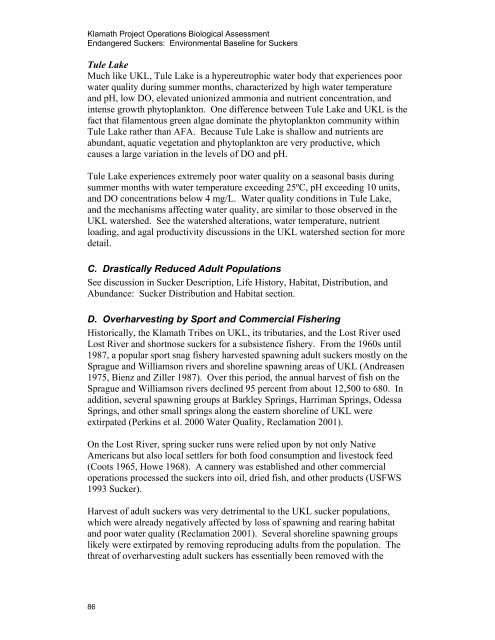Our new Biological Assessment is out - Klamath Basin Crisis
Our new Biological Assessment is out - Klamath Basin Crisis
Our new Biological Assessment is out - Klamath Basin Crisis
Create successful ePaper yourself
Turn your PDF publications into a flip-book with our unique Google optimized e-Paper software.
<strong>Klamath</strong> Project Operations <strong>Biological</strong> <strong>Assessment</strong><br />
Endangered Suckers: Environmental Baseline for Suckers<br />
Tule Lake<br />
Much like UKL, Tule Lake <strong>is</strong> a hypereutrophic water body that experiences poor<br />
water quality during summer months, characterized by high water temperature<br />
and pH, low DO, elevated unionized ammonia and nutrient concentration, and<br />
intense growth phytoplankton. One difference between Tule Lake and UKL <strong>is</strong> the<br />
fact that filamentous green algae dominate the phytoplankton community within<br />
Tule Lake rather than AFA. Because Tule Lake <strong>is</strong> shallow and nutrients are<br />
abundant, aquatic vegetation and phytoplankton are very productive, which<br />
causes a large variation in the levels of DO and pH.<br />
Tule Lake experiences extremely poor water quality on a seasonal bas<strong>is</strong> during<br />
summer months with water temperature exceeding 25ºC, pH exceeding 10 units,<br />
and DO concentrations below 4 mg/L. Water quality conditions in Tule Lake,<br />
and the mechan<strong>is</strong>ms affecting water quality, are similar to those observed in the<br />
UKL watershed. See the watershed alterations, water temperature, nutrient<br />
loading, and agal productivity d<strong>is</strong>cussions in the UKL watershed section for more<br />
detail.<br />
C. Drastically Reduced Adult Populations<br />
See d<strong>is</strong>cussion in Sucker Description, Life H<strong>is</strong>tory, Habitat, D<strong>is</strong>tribution, and<br />
Abundance: Sucker D<strong>is</strong>tribution and Habitat section.<br />
D. Overharvesting by Sport and Commercial F<strong>is</strong>hering<br />
H<strong>is</strong>torically, the <strong>Klamath</strong> Tribes on UKL, its tributaries, and the Lost River used<br />
Lost River and shortnose suckers for a subs<strong>is</strong>tence f<strong>is</strong>hery. From the 1960s until<br />
1987, a popular sport snag f<strong>is</strong>hery harvested spawning adult suckers mostly on the<br />
Sprague and Williamson rivers and shoreline spawning areas of UKL (Andreasen<br />
1975, Bienz and Ziller 1987). Over th<strong>is</strong> period, the annual harvest of f<strong>is</strong>h on the<br />
Sprague and Williamson rivers declined 95 percent from ab<strong>out</strong> 12,500 to 680. In<br />
addition, several spawning groups at Barkley Springs, Harriman Springs, Odessa<br />
Springs, and other small springs along the eastern shoreline of UKL were<br />
extirpated (Perkins et al. 2000 Water Quality, Reclamation 2001).<br />
On the Lost River, spring sucker runs were relied upon by not only Native<br />
Americans but also local settlers for both food consumption and livestock feed<br />
(Coots 1965, Howe 1968). A cannery was establ<strong>is</strong>hed and other commercial<br />
operations processed the suckers into oil, dried f<strong>is</strong>h, and other products (USFWS<br />
1993 Sucker).<br />
Harvest of adult suckers was very detrimental to the UKL sucker populations,<br />
which were already negatively affected by loss of spawning and rearing habitat<br />
and poor water quality (Reclamation 2001). Several shoreline spawning groups<br />
likely were extirpated by removing reproducing adults from the population. The<br />
threat of overharvesting adult suckers has essentially been removed with the<br />
86










